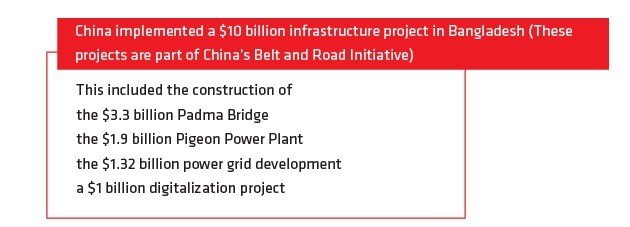Within the context of its Strategic Partnership of Cooperation with Bangladesh, China played a vital role in opposing external powers’ interference during its election in 2024. The Bangladesh-China relationship, founded on mutual respect and mutual benefits, flourished in 2023, marked by completed infrastructure projects, increased Chinese investment, and numerous job opportunities for the local population.
When we look back in 2023, global dynamics experienced significant shifts, marked by the aftermath of the COVID-19 pandemic, economic recovery efforts, and ongoing geopolitical challenges such as the Ukraine crisis impacting food and energy security. Amidst these challenges, China emerged as a key player, actively promoting a new type of international relations and a shared future for humanity. The nation aimed to inject peace, stability, and development into the turbulent global landscape and no wonder, Bangladesh has got enormous attention to its policy structure.
You can also read: India: 10 Years of Modi Budgets
Cultural and personnel exchanges between Bangladesh and China flourished, with the two nations fostering closer ties in various sectors. China expressed solidarity during Bangladesh’s battle against a severe dengue epidemic, providing timely assistance to local hospitals. Looking ahead, China expressed readiness to collaborate further with Bangladesh, emphasizing economic complementarity, joint competitiveness, and strategic integration through initiatives like the Belt and Road Cooperation, the Global Development Initiative, the Global Security Initiative, and the Global Civilization Initiative. The goal is to elevate Bangladesh-China relations to new heights on the 50th anniversary of diplomatic ties.
Trade Relations:
In 2023, the trade relations between Bangladesh and China laid a solid foundation for the future. China exported $24.1B to Bangladesh, with the main products being Light Rubberized Knitted Fabric, Refined Petroleum, and Vaccines. Bangladesh exported $1.01B to China, with Jute Yarn, Tanned Equine and Bovine Hides, and Knit T-shirts being the primary exports.
In November 2023, China exported $1.82B and imported $87.8M from Bangladesh, resulting in a positive trade balance of $1.73B. The top exports of China to Bangladesh were Synthetic Filament Yarn Woven Fabric, Heavy Mixed Woven Cotton, and Vaccines. The top imports of China from Bangladesh were Jute Yarn, Knit T-shirts, and Tanned Equine and Bovine Hides.
China, as a key trading partner, has emerged as a pivotal force in bolstering Bangladesh’s economic landscape. Robust infrastructural projects, such as the Belt and Road Initiative (BRI), have solidified the nations’ economic interdependence. The strategic alignment of interests has not only facilitated increased trade volumes but has also paved the way for technology transfer, skill development, and knowledge-sharing initiatives.
The implementation of Bangladesh’s 2021-2024 export policy and duty-free access to China for 98 percent of Bangladeshi products is expected to resume growth in bilateral trade. This robust trade relationship between Bangladesh and China in 2023 has indeed laid a solid foundation for their future economic partnership.
Moreover, the collaborative spirit extends beyond traditional sectors, encompassing cutting-edge fields like technology, renewable energy, and digital innovation. The synergy in economic policies and the commitment to fostering sustainable development underscores the long-term vision that both nations share.
Investment:
There has been a growing inclination among Chinese enterprises to invest in Bangladesh, spanning diverse sectors such as infrastructure, energy, and telecommunications. Bangladesh has actively pursued Chinese investments to bolster its economic progress, resulting in ongoing discussions about potential collaborative projects between the two nations. The trade ties between Bangladesh and China strengthened in 2023, establishing a sturdy groundwork for future collaborations. Notably, China’s investment in Bangladesh’s trade sector experienced substantial expansion during this period.

These developments indicate a promising future for Bangladesh-China trade relations, with China’s increasing interest in investing in Bangladesh’s trade sector. According to the American Enterprise Institute (AEI), a US-based think tank, China’s total investment in Bangladesh stands at $7.07 billion. Additionally, Chinese companies have secured construction contracts valued at $22.94 billion across diverse sectors.
Over the past decade, China has allocated $4.45 billion for 35 projects under the Belt and Road Initiative (BRI), as disclosed by the Chinese Ambassador to Bangladesh, Yao Wen.
Infrastructure Development:
China has actively participated in numerous significant infrastructure undertakings in Bangladesh, with the construction of the Padma Bridge standing out as a notable example. In this project, China has been extending both financial and technical support. Several other projects in Bangladesh also benefit from China’s crucial assistance in various capacities.
In 2023, the infrastructure development between Bangladesh and China in the trade sector saw significant progress.

Bangladesh is constructing high-quality infrastructure, such as power plants, bridges, highways, railways, and ports, in collaboration with China3. This infrastructure development has not only strengthened the trade relations between the two countries but also laid a solid foundation for future growth
Free Trade Agreement (FTA):
In 2023, the Free Trade Agreement (FTA) between Bangladesh and China was a significant topic of discussion. Both nations showed interest in signing an FTA, but the potential impacts were yet to be fully examined. The proposed FTA could potentially worsen aggregate welfare in Bangladesh but also offer opportunities for overall welfare improvement by partially protecting its domestic market for Chinese imports. Despite concerns, the Chinese Ambassador to Bangladesh advocated for an FTA combined with an investment deal. The FTA negotiations sparked unease in India, highlighting the regional implications of this bilateral agreement. These developments underscore the complexity and potential of the Bangladesh-China trade relationship in the context of the FTA.
Belt and Road Initiative (BRI):
In 2023, The Belt and Road Initiative (BRI) continued to strengthen trade ties between Bangladesh and China. Bangladesh reassessed its BRI strategy, with several key projects scrapped due to various factors. Bangladesh has expressed interest in participating in China’s Belt and Road Initiative, which aims to enhance connectivity and cooperation between countries through infrastructure development. The two nations have been discussing potential projects under this initiative.
However, China’s investments in Bangladesh, exceeding $4.45 billion over 10 years, contributed to improving living standards. Infrastructure projects like the Padma Bridge and Pigeon Power Plant, part of the BRI, symbolize this robust partnership. Despite challenges, the BRI has brought transformative changes to Bangladesh, reinforcing its role as a vital connector in the regional trade network.
Challenges and Concerns:
While the economic relationship has been generally positive, there have been concerns about trade imbalances, with Bangladesh importing more from China than it exports. This has led to discussions on ways to address this imbalance.
From highways to railways, seaports to airports, subterranean tunnels to elevated expressways, water utilities to e-governance, and coal to solar energy, China’s influence permeates various sectors in Bangladesh, contributing funds, technology, and expertise.
As 2023 unfolds, the trajectory of Bangladesh and China’s trade relations promises not only economic prosperity but also signifies a paradigm shift towards a more interconnected and interdependent global economy. The foundation laid during this period is poised to catalyze transformative growth, creating opportunities for both nations to navigate the future hand in hand.


